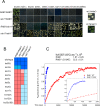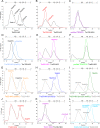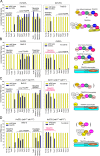Characterization of Aspergillus nidulans TRAPPs uncovers unprecedented similarities between fungi and metazoans and reveals the modular assembly of TRAPPII
- PMID: 31869332
- PMCID: PMC6946167
- DOI: 10.1371/journal.pgen.1008557
Characterization of Aspergillus nidulans TRAPPs uncovers unprecedented similarities between fungi and metazoans and reveals the modular assembly of TRAPPII
Abstract
TRAnsport Protein Particle complexes (TRAPPs) are ubiquitous regulators of membrane traffic mediating nucleotide exchange on the Golgi regulatory GTPases RAB1 and RAB11. In S. cerevisiae and metazoans TRAPPs consist of two large oligomeric complexes: RAB11-activating TRAPPII and RAB1-activating TRAPPIII. These share a common core TRAPPI hetero-heptamer, absent in metazoans but detected in minor proportions in yeast, likely originating from in vitro-destabilized TRAPPII/III. Despite overall TRAPP conservation, the budding yeast genome has undergone extensive loss of genes, and lacks homologues of some metazoan TRAPP subunits. With nearly twice the total number of genes of S. cerevisiae, another ascomycete Aspergillus nidulans has also been used for studies on TRAPPs. We combined size-fractionation chromatography with single-step purification coupled to mass-spectrometry and negative-stain electron microscopy to establish the relative abundance, composition and architecture of Aspergillus TRAPPs, which consist of TRAPPII and TRAPPIII in a 2:1 proportion, plus a minor amount of TRAPPI. We show that Aspergillus TRAPPIII contains homologues of metazoan TRAPPC11, TRAPPC12 and TRAPPC13 subunits, absent in S. cerevisiae, and establish that these subunits are recruited to the complex by Tca17/TRAPPC2L, which itself binds to the 'Trs33 side' of the complex. Thus Aspergillus TRAPPs compositionally resemble mammalian TRAPPs to a greater extent than those in budding yeast. Exploiting the ability of constitutively-active (GEF-independent, due to accelerated GDP release) RAB1* and RAB11* alleles to rescue viability of null mutants lacking essential TRAPP subunits, we establish that the only essential role of TRAPPs is activating RAB1 and RAB11, and genetically classify each essential subunit according to their role(s) in TRAPPII (TRAPPII-specific subunits) or TRAPPII and TRAPPIII (core TRAPP subunits). Constitutively-active RAB mutant combinations allowed examination of TRAPP composition in mutants lacking essential subunits, which led to the discovery of a stable Trs120/Trs130/Trs65/Tca17 TRAPPII-specific subcomplex whose Trs20- and Trs33-dependent assembly onto core TRAPP generates TRAPPII.
Conflict of interest statement
The authors have declared that no competing interests exist.
Figures







